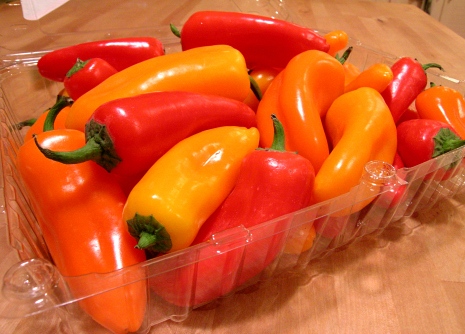I’ve been seeing these adorable little sweet peppers in the grocery stores lately. I hadn’t bought them because they’re quite pricey — $4.99 to $5.99 for a 681 gram (1.5 lb.) bin, depending on the store. That’s more than regular sweet bell peppers, which I refuse to buy once they go over $3.99 a pound.

But they’re so adorable! So what the heck, I bought some on Sunday.
They’re the size of jalapeño peppers, but are less fleshy and are not hot. But neither are they as sweet as regular bell peppers (and again, not as fleshy). So what are they, and what does one do with them?
Eating them raw, they have just the slightest hint — more like a memory — of peppery hotness and something of a jalapeño flavor, but not quite. In other words, I think they’re some kind of jalapeño hybrid that is neither one thing nor the other. There’s nothing wrong with hot peppers, and sweet peppers are excellent too. With these guys you get neither the hot nor the sweet, so what’s the point?
They’re not completely useless. They have a nice crunchy texture, and you can cut them up and put them in a salad. But if you’re going to cut them up, why not just pay less and get a red bell pepper?
I tried roasting a couple of them, but since the flesh is quite thin they didn’t roast very well (although I may have left them in the oven too long). It seems like the best thing about these peppers is their looks. They’re decorative.
I don’t regret buying them. It was only five bucks after all, and they were nice in last night’s salad and were fun to eat whole next to a sandwich at lunchtime. But I doubt I will buy them again unless I need something colorful for a crudité plate.
Note: Have you taken the Blork Blog survey? If not, please do so. It’s quick and anonymous. (Survey closed.)